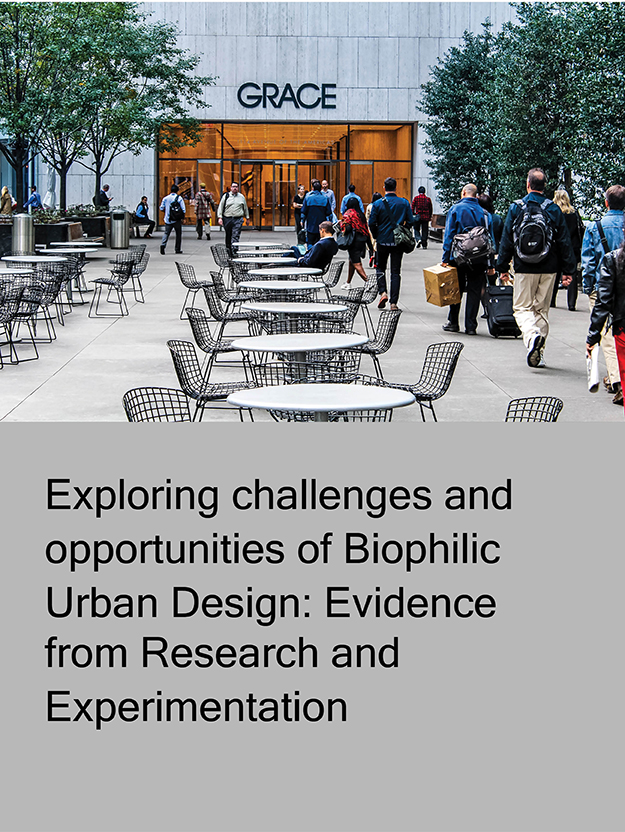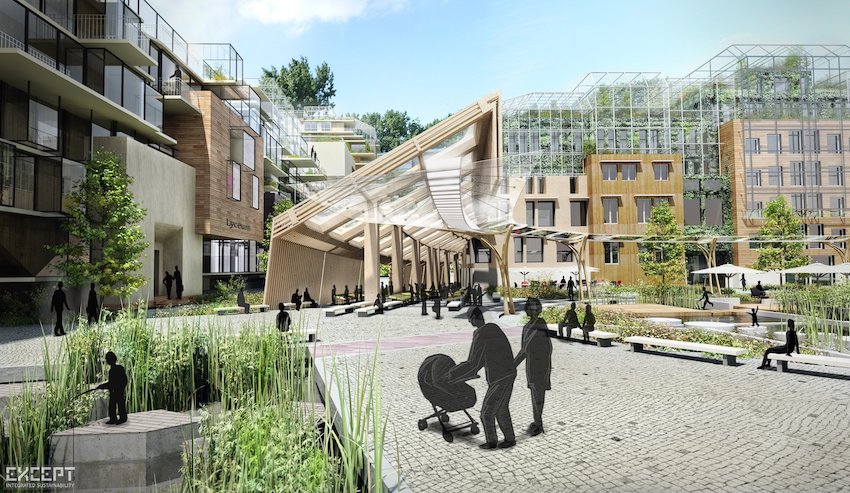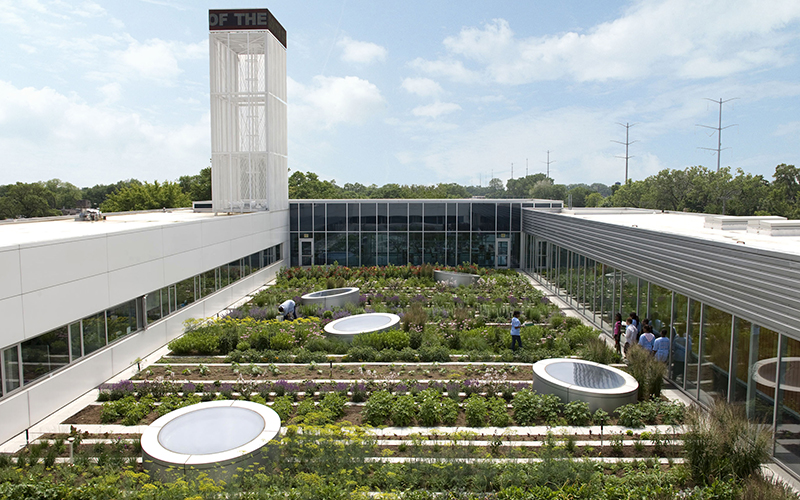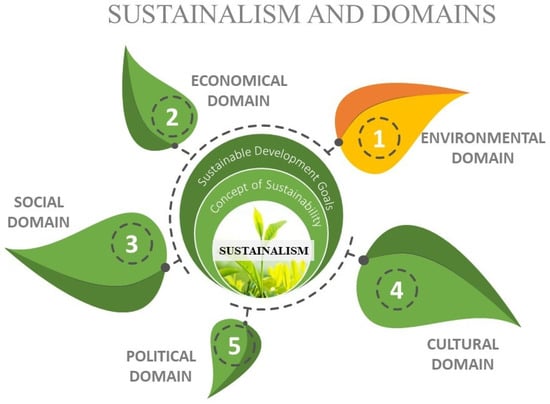Policy Challenges in Implementing Urban Biophilic Design.
In an increasingly urbanized world, the integration of nature into city landscapes, referred to as **urban biophilic design** (a key component of sustainable urban planning), is becoming essential.
This approach not only enhances the aesthetic appeal of urban environments but also improves **mental and physical health**, increases **biodiversity** and improves **ecological design**, and fosters a sense of **well-being** among residents.
However, the implementation of such designs presents challenges, including **limited space and resources** and **resistance from stakeholders**.
It is important to examine inspiring examples of successful **biophilic projects** that are transforming urban living.
What is Urban Biophilic Design?
.jpg_00.jpeg)
Urban biophilic design represents a progressive approach to urban planning that prioritizes the incorporation of natural elements and innovative nature-based solutions within the built environment. This design philosophy fosters habitat connectivity and a meaningful connection between individuals and nature, thereby enhancing the quality of living spaces.
It aims not only to elevate the aesthetic value and ecological benefits of urban landscapes and urban design but also to promote sustainability and urban mobility, climate resilience, and public health through the integration of green infrastructure.
By employing nature-based solutions and addressing the urban heat island and urban heat mitigation effects, urban biophilic design plays a crucial role in enhancing biodiversity, urban biodiversity, and ecosystem services.
Ultimately, this approach contributes to the development of a holistic and livable urban environment while taking into account cultural context and social equity.
Why is Urban Biophilic Design Important?
Urban biophilic design is crucial as it profoundly influences public health, quality of life, and community resilience and social cohesion by integrating green spaces and natural elements into urban environments.
This design approach promotes mental health and well-being through exposure to nature and urban greenways while simultaneously enhancing urban biodiversity and ecological sustainability.
Moreover, urban biophilic design fosters social sustainability and environmental justice by addressing health disparities and improving access to green infrastructure for all members of the community.
This methodology cultivates a sense of place and encourages citizen engagement in urban renewal and neighborhood revitalization initiatives, thereby contributing to climate adaptation and sustainable development.
1. Improves Mental and Physical Health
Urban biophilic design significantly enhances urban form enhances mental and physical health by incorporating natural elements into urban environments, thereby providing residents with opportunities for nature exposure that promote well-being and alleviate stress.
Research has demonstrated that access to green spaces and nature-based urban solutions and urban forests and urban forestry can lead to improved mood, reduced stress levels, and overall enhancement of physical health. The integration of nature in urban planning is also effective in addressing challenges such as the urban heat island effect, which contributes to improved air quality and encourages outdoor physical activities essential for a healthy lifestyle.
Initiatives like the High Line in New York City serve as prime examples of successful urban biophilic design, transforming previously unused rail tracks into a vibrant green space that fosters community interaction and promotes physical activity.
Further research indicates that urban areas and smart cities that prioritize green roofs, urban agriculture initiatives, and parks can significantly lower cortisol levels, underscoring the importance of nature in stress reduction. Environmental assessments reveal that residents living in biodiverse urban areas experience reduced anxiety and enhanced cognitive functions, highlighting the profound impact that nature-integrated spaces can have on the overall health of urban populations.
2. Increases Biodiversity
Urban biophilic design plays a vital role in enhancing urban biodiversity by integrating diverse plant species and creating habitats within urban environments. This approach not only improves ecological design but also supports the restoration of urban ecosystems, providing essential ecosystem services and addressing land use challenges such as pollination, water management, and temperature regulation.
By developing green spaces and employing urban design principles and urban wildlife habitats, cities can cultivate a more resilient urban environment that adapts to climate change while promoting community engagement and environmental stewardship.
The significance of urban biodiversity extends beyond environmental health; it also contributes to the social and psychological well-being of urban residents. For instance, the High Line in New York City has transformed an abandoned railway into a thriving green space, attracting numerous species and providing residents with an oasis amidst the concrete landscape.
Similarly, Singapore’s Gardens by the Bay exemplifies how thoughtful design can restore habitats and create educational opportunities regarding the importance of biodiversity.
Through these initiatives, urban biophilic design not only replenishes ecosystems but also fosters a deeper connection and resilience planning between individuals and nature, which is essential for sustainable urban living.
3. Enhances Urban Aesthetics
Urban biophilic design significantly enhances urban aesthetics by integrating natural elements into the built environment, thereby creating visually appealing landscapes that foster a sense of place and community identity.
This design approach underscores the aesthetic value of green infrastructure, such as urban forests, gardens, and parks, which can transform uninspiring urban settings into vibrant spaces that promote social interaction and recreational activities.
By prioritizing the incorporation of nature, urban planners and landscape architecture and architects can enhance the overall livability of cities, making them more attractive to both residents and visitors.
Utilizing principles of landscape architecture, urban biophilic design contributes to the creation of environments that are not only functional but also visually captivating.
This deliberate integration of greenery introduces a layer of visual interest that mitigates the monotony of concrete structures, establishing a harmonious balance between the natural and built environments.
Furthermore, engaging the community through participatory design processes enables residents to influence the development of these spaces, thereby fostering a greater sense of ownership and belonging.
Consequently, cities transform into more than mere places of residence; they develop into vibrant ecosystems where aesthetics and functionality coexist, enriching the daily experiences of all who inhabit them.
What are the Challenges in Implementing Urban Biophilic Design?
Despite the numerous benefits associated with urban biophilic design, significant challenges and regulatory barriers exist in its implementation. These challenges include policy-related obstacles, funding mechanisms, and regulatory frameworks that may impede progress.
The involvement and collaboration of stakeholders are essential to overcoming these barriers, as differing interests can complicate urban planning processes. Furthermore, the limited space and resources and systemic barriers in densely populated areas present practical challenges, necessitating that urban planners adeptly navigate complex zoning laws and municipal regulations to effectively integrate nature-based solutions into urban landscapes.
1. Limited Space and Resources
.jpg_01.jpeg)
One of the primary challenges in implementing urban biophilic design is the limited space and resources available in urban areas, where competing land uses complicate effective resource allocation and planning.
The urban heat island effect further exacerbates this issue, underscoring the need for efficient spatial planning that prioritizes green infrastructure and urban agriculture. Strategies such as the adaptive reuse and policy innovation of existing structures can optimize the use of available space while integrating green elements, thereby contributing to climate resilience and sustainable development.
City planners and architects are increasingly adopting innovative techniques that enable the integration of nature into urban environments. Vertical gardens and rooftop farms represent exemplary solutions, converting underutilized areas into vibrant green spaces. These innovations not only enhance biodiversity but also improve air quality and mitigate stormwater runoff, which is essential in densely populated urban settings.
By prioritizing these advanced strategies, stakeholders can effectively address the constraints imposed by urban landscapes and policy frameworks and make substantial progress toward a more sustainable future.
2. Lack of Awareness and Understanding of Policy Challenges
A significant barrier to the implementation of urban biophilic design is the lack of awareness and understanding among stakeholders in the context of policy integration, including local communities, policymakers, and urban planners. It is crucial to engage in educational outreach and enhance ecological literacy to foster a shared understanding of the benefits and importance of integrating nature into urban environments.
By promoting workshops, seminars, and community forums, stakeholders can clarify the concepts associated with biophilic design and green infrastructure investments, making them more accessible to a broader audience. Collaborative projects, which involve local residents in the design and maintenance of green spaces, not only strengthen community ties and encourage behavioral change but also cultivate a sense of stewardship toward the environment.
Additionally, utilizing visual storytelling through digital platforms can significantly increase awareness, showcasing successful real-world examples of biophilic projects. Such initiatives give the power to individuals and groups, illustrating how collective action can contribute to a more sustainable urban future while reinforcing the vital role of community engagement in participatory governance.
3. Resistance to Change
Resistance to change from various stakeholders can significantly impede the adoption of urban biophilic design practices, particularly as traditional urban planning methods are often deeply entrenched in existing regulatory frameworks, policy challenges, and construction practices.
This resistance typically arises from apprehensions regarding the unknown, budget limitations, and the complexities associated with navigating the regulations governing land use, environmental impacts, and ecological design.
By thoroughly understanding and analyzing these factors, it becomes evident that developing design guidelines tailored to the specific cultural context of each community is essential for bridging the divide between innovation and tradition, promoting social equity and environmental justice.
The importance of collaboration among all stakeholders cannot be overstated; such teamwork can facilitate discussions that elucidate the benefits of biophilic design, promote regulatory compliance, and ultimately result in a more harmonious integration of nature within urban environments, enhancing community resilience and urban ecosystems.
How Can These Challenges be Overcome?
Overcoming the challenges associated with the implementation of urban biophilic design necessitates strategic collaboration among various stakeholders, the adoption of innovative participatory design methodologies, and the establishment of effective funding mechanisms that prioritize green infrastructure projects, urban agriculture initiatives, and renewable resources.
By fostering partnerships between government entities, private sectors, and local communities, urban planners can effectively leverage collective resources to mitigate implementation barriers, enhance policy integration, and promote urban sustainability.
Additionally, the adaptive reuse of existing structures can be strategically utilized to incorporate biophilic elements into urban environments, while also addressing the impacts of climate change through appropriate climate adaptation strategies and resilience planning.
1. Utilizing Vertical Space
An effective strategy for addressing space limitations in urban biophilic design involves the utilization of vertical space through features such as vertical gardens and green walls. These approaches optimize available land while seamlessly integrating nature into the built environment.
Such biophilic features not only enhance the aesthetic appeal of urban areas but also contribute to urban agriculture and improve landscape connectivity, thereby fostering a healthier urban ecosystem. By maximizing vertical space, cities can effectively tackle resource allocation challenges and enhance climate resilience.
For example, the Bosco Verticale in Milan serves as a prime illustration of this concept, showcasing residential towers adorned with thousands of trees and plants that significantly boost local biodiversity. Additionally, innovative projects such as urban farms established on rooftops further exemplify the integration of vertical gardening, allowing urban residents to cultivate their own food while simultaneously mitigating the urban heat island effect.
The implementation of vertical installations can also create green corridors that connect fragmented ecosystems, facilitating wildlife movement and enhancing the overall quality of life for residents. These applications demonstrate the transformative potential of design approaches that prioritize the vertical dimension to promote sustainability and community well-being.
2. Education and Outreach Programs
The implementation of education and outreach programs is essential for fostering ecological literacy and enhancing community engagement in urban biophilic design initiatives. By informing stakeholders about the advantages of biophilic design and promoting social inclusion, such programs can address gaps in understanding and cultivate support for green infrastructure projects.
Involving communities in participatory governance processes ensures that diverse perspectives are acknowledged, resulting in more effective urban planning outcomes that integrate community-led initiatives and stakeholder collaboration.
These programs can manifest in various forms, including:
- Workshops
- Community gardening initiatives
- Guided nature walks
All designed to encourage active participation and facilitate deeper connections with local ecosystems. For instance, a city may conduct a series of hands-on urban gardening camps that educate residents about native plant species while also advocating for the installation of green roofs and walls in their neighborhoods.
Moreover, successful initiatives such as the ‘Green Schoolyards’ project in multiple urban areas illustrate how schools can serve as centers for ecological education and community involvement. These initiatives foster a sense of stewardship among younger generations and contribute to the creation of greener, healthier urban spaces.
Consequently, these educational efforts significantly empower communities to advocate for sustainable practices, embrace biophilic principles, and engage in policy innovation within their urban environments.
3. Collaboration between Government and Private Sectors
.jpg_10.jpeg)
Collaboration between government entities and the private sector is essential for the successful implementation of urban biophilic design, as it fosters synergies that facilitate funding mechanisms, streamline regulatory frameworks, and promote interdisciplinary approaches.
Public-private partnerships enhance stakeholder collaboration, ensuring that a diverse range of interests is represented in urban policy-making processes. By joining forces, these sectors can develop innovative solutions to address implementation barriers and promote sustainable development.
For example, cities such as Singapore and Copenhagen illustrate how such alliances can cultivate vibrant green spaces that attract both residents and tourists, advancing landscape architecture and enhancing urban mobility.
In Singapore, the Gardens by the Bay project exemplifies how local authorities and private investors can collaboratively transform urban landscapes through sustainable, nature-centric designs. Similarly, Copenhagen’s partnership with private organizations for the construction of bike lanes and green roofs underscores the effectiveness of combined resources in enhancing urban livability.
These case studies demonstrate that when governmental and private interests are aligned, they can create multifaceted benefits that address challenges related to climate resilience, urban biodiversity, and urban livability while simultaneously improving the overall quality of urban life.
What are Some Successful Examples of Urban Biophilic Design Implementation?
Numerous successful examples of urban biophilic design implementation illustrate the effectiveness of nature-based solutions in enhancing urban environments, promoting community engagement, and addressing urban density challenges.
Notable projects such as Singapore’s Gardens by the Bay, New York City’s High Line, and Copenhagen’s Green Roof Policy exemplify innovative strategies for integrating green infrastructure. These initiatives not only promote biodiversity but also contribute to improved public health through considered urban renewal approaches.
The case studies underscore the transformative potential of urban biophilic design in creating vibrant and sustainable urban landscapes that support urban renewal and community cohesion.
1. Singapore’s Gardens by the Bay
Gardens by the Bay in Singapore exemplifies urban biophilic design through its innovative integration of green infrastructure, which enhances biodiversity and public spaces. This iconic garden features the Supertree Grove, designed to promote environmental sustainability while providing visitors with stunning views and recreational opportunities.
By harmonizing nature with the urban environment, Gardens by the Bay illustrates the potential of biophilic design to enrich urban ecosystems, improve overall quality of life, and foster nature connection.
Within its expansive grounds, the facility includes two conservatories, the Flower Dome and the Cloud Forest, showcasing how climate-controlled environments can support a diverse array of plant species. This thoughtful design not only offers educational opportunities for visitors but also serves as a crucial sanctuary for flora that may be at risk in other environments.
By engaging the community through workshops and events, the garden cultivates a deeper appreciation for the natural world, encouraging individuals to actively participate in sustainability efforts and promoting biodiversity within the vibrant cityscape.
2. New York City’s High Line
The High Line in New York City serves as a prominent example of urban biophilic design, successfully transforming an abandoned elevated rail line into a vibrant green space that fosters community engagement, promotes urban heat mitigation, and enhances urban landscapes.
This innovative project incorporates a diverse array of plant species and provides recreational areas while adhering to ecological design principles. The High Line not only exemplifies urban renewal but also underscores the significance of landscape architecture in creating accessible and livable urban environments.
It has become a central hub for cultural activities and social interaction, attracting both locals and tourists to its pathways, which meander through art installations, seating areas, and landscaped gardens.
By prioritizing sustainability and inclusivity, the High Line demonstrates how thoughtfully designed open spaces can revitalize surrounding neighborhoods, contribute to improved air quality, promote habitat restoration, and enhance biodiversity.
This successful integration of nature within an urban context illustrates the potential of landscape architecture to inspire community collaboration, cultivate a strong sense of place, and support urban forestry, ultimately reshaping how urban dwellers perceive and interact with their environment.
3. Copenhagen’s Green Roof Policy
Copenhagen’s Green Roof Policy serves as a notable example of effective urban biophilic design, demonstrating a commitment to climate resilience and the enhancement of urban biodiversity. By integrating ecological design principles and prioritizing nature-based solutions, this policy mandates the installation of green roofs on new buildings, which not only improves air quality and mitigates the urban heat island effect but also provides habitats for various species, thereby contributing to urban biodiversity and urban ecosystems.
By enforcing environmentally responsible practices, Copenhagen illustrates how robust environmental policies can facilitate sustainable development, urban renewal, and the integration of green infrastructure. This approach promotes sustainability and the creation of interconnected urban greenways that enhance community resilience and urban livability.
These green roofs function as natural water retention systems, mitigating stormwater runoff and alleviating the strain on urban drainage systems during periods of heavy rainfall. They also contribute to urban heat mitigation by providing insulation. By adopting such innovative solutions, the city addresses immediate environmental challenges while establishing a benchmark for urban areas globally, fostering public awareness and encouraging urban sustainability.
The implications of this policy extend beyond mere aesthetics; they play a vital role in advancing ecological networks, facilitating pollinator pathways, and enhancing the urban ecosystem. Such policies also offer significant ecological benefits and contribute to habitat restoration and connectivity, supporting urban wildlife and community engagement.
As other cities seek to replicate Copenhagen’s approach, the emphasis on collaborative urban planning and stakeholder engagement becomes essential in creating frameworks that harmonize growth with environmental health. This involves overcoming regulatory barriers, engaging in participatory planning, and ensuring policy integration to achieve sustainable development goals and social equity.
Frequently Asked Questions
What is urban biophilic design?
.jpg_11.jpeg)
Urban biophilic design is an approach to urban planning that incorporates natural elements and features into the built environment, with the goal of creating a more sustainable and biologically diverse city.
|||
Urban biophilic design is an approach to urban planning that incorporates natural elements and features into the built environment, with the goal of creating a more sustainable and biologically diverse city. It encompasses practices that enhance urban form, reduce ecological footprint, and foster nature connection within urban spaces.
Urban biophilic design is an approach to urban planning that incorporates natural elements and features into the built environment, with the goal of creating a more sustainable and biologically diverse city.
What are some examples of urban biophilic design elements?
Some examples of urban biophilic design elements include green roofs, living walls, urban gardens, natural water features, and the use of natural materials such as wood and stone in buildings.
|||
Some examples of urban biophilic design elements include green roofs, living walls, urban gardens, urban forestry, natural water features, and the use of natural materials such as wood and stone in buildings. These elements contribute to the overall wellbeing and connectivity of urban spaces.
Some examples of urban biophilic design elements include green roofs, living walls, urban gardens, natural water features, and the use of natural materials such as wood and stone in buildings.
What are some policy challenges in implementing urban biophilic design?
Some policy challenges in implementing urban biophilic design include lack of funding, conflicting priorities in urban planning, and resistance to change from traditional building and development practices.
|||
Some policy challenges in implementing urban biophilic design include lack of funding, conflicting priorities in urban planning, systemic barriers, and resistance to change from traditional building and development practices. Addressing these challenges requires innovative policy frameworks and stakeholder collaboration.
Some policy challenges in implementing urban biophilic design include lack of funding, conflicting priorities in urban planning, and resistance to change from traditional building and development practices.
How can policies be used to support urban biophilic design?
Policies can be used to support urban biophilic design by offering incentives for developers and building owners to incorporate biophilic elements, setting green building standards, and creating regulations for urban green spaces.
|||
Policies can be used to support urban biophilic design by offering incentives for developers and building owners to incorporate biophilic elements, setting green building standards, creating regulations for urban green spaces, and promoting landscape architecture. Such policies also encourage urban agriculture initiatives and align with climate action goals.
Policies can be used to support urban biophilic design by offering incentives for developers and building owners to incorporate biophilic elements, setting green building standards, and creating regulations for urban green spaces.
What are the potential benefits of implementing urban biophilic design?
The potential benefits of implementing urban biophilic design include improved air and water quality, reduced urban heat island effect, increased biodiversity, and improved mental and physical health for city residents.
|||
The potential benefits of implementing urban biophilic design include improved air and water quality, reduced urban heat island effect, increased biodiversity, enhanced public health, and improved mental and physical health for city residents. Additionally, these designs support environmental justice, community resilience, and social cohesion.
The potential benefits of implementing urban biophilic design include improved air and water quality, reduced urban heat island effect, increased biodiversity, and improved mental and physical health for city residents.
What are some challenges in measuring the effectiveness of urban biophilic design policies?
Some challenges in measuring the effectiveness of urban biophilic design policies include the lack of standardized metrics, the complexity of measuring the impact of natural elements on urban environments, and the need for long-term data collection and analysis.
|||
Some challenges in measuring the effectiveness of urban biophilic design policies include the lack of standardized metrics, the complexity of measuring the impact of natural elements on urban environments, and the need for long-term data collection and analysis. Additionally, understanding the economic impacts, behavioral change, and policy innovation required to support these designs is crucial.
Some challenges in measuring the effectiveness of urban biophilic design policies include the lack of standardized metrics, the complexity of measuring the impact of natural elements on urban environments, and the need for long-term data collection and analysis.

I’m Bruno, an architect with a deep passion for Biophilic Design in Urban Architecture. Throughout my career, I’ve focused on integrating natural elements into urban planning, and I created this site to share my insights and foster a deeper understanding of how biophilic principles can significantly enhance urban living. Dedicated to sustainable development, I continually explore innovative design solutions that promote both environmental and human well-being in city landscapes.














Publicar comentário